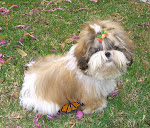


"I found these little yellow-orange things on my Milkweed. Are they eggs?" Sorry, they are NOT eggs but are Aphids. The common name for them is Oleander Aphid or Milkweed Aphid).
*Click on picture to enlarge*
The Aphis nerii are sap suckers and will literally drain your plant of its 'life juices.' They leave behind a 'honeydew' that can then develop a black, sooty mold-like substance and this leaves the Milkweed looking rather sad and pathetic. Many times, you will find Ants nearby. With repeated Aphid 'attacks,' Milkweed can become severely deformed in its growth.
This is an interesting insect in several ways. They are an obligate parthenogenetic species which means that all of the adults are females. Some have wings and these are called alata and the wingless ones are called apterae. The adults do not lay eggs but deposit nymphs that are basically clones of the adult female. Are Oleander Aphids are harmful to Milkweed? Well, let's just say this: when I see them on my Milkweed, I go ballistic! Why? Because they will 1) soon multiply like crazy, 2) force me into extra work, 3) suck all the life out of my plants, … I do NOT want them on my plants. Period. I use JUST WATER to get rid of them. I use a heavy stream/spray of water and blast away. If the plants wilt, don't worry as they will spring right back. Using soap, insecticidal soap, sprays, etc. will only coat the Milkweed with chemicals that can be potentially harmful to any Monarch caterpillar that might eat the leaves. A strong spray of water easily washes the Aphids off of the plant. (if you have any aggressions at the time, blast away!)
Are Oleander Aphids are harmful to Milkweed? Well, let's just say this: when I see them on my Milkweed, I go ballistic! Why? Because they will 1) soon multiply like crazy, 2) force me into extra work, 3) suck all the life out of my plants, … I do NOT want them on my plants. Period. I use JUST WATER to get rid of them. I use a heavy stream/spray of water and blast away. If the plants wilt, don't worry as they will spring right back. Using soap, insecticidal soap, sprays, etc. will only coat the Milkweed with chemicals that can be potentially harmful to any Monarch caterpillar that might eat the leaves. A strong spray of water easily washes the Aphids off of the plant. (if you have any aggressions at the time, blast away!)
If you are raising Monarch butterflies, think about employing another good anti-Aphid control: the Ladybug or Ladybird Beetle. These little critters are great because they eat the Aphids! Their larvae (babies) also eat Aphids so having them around is a plus.
*Just keep in mind that Ladybugs will also eat butterfly eggs and young caterpillars! If you are not out there harvesting the eggs and caterpillars, your Ladybugs are probably saying, "MMM! Yummy!"
Note: Controversies exist as to whether or not Monarch larvae actually eat the Aphids...who knows? I haven't witnessed it myself. As to whether or not it is harmful to simply leave the Aphids ON the plants, well, it is up to you. Just keep in mind that these critters will eventually destroy your plants and they multiply quite rapidly! Personally, I prefer to have Asclepias plants Aphid-free.
PS: If you squish these Aphids with your fingers, your fingers will turn an orange-yellow colour.
By the way, Ladybug eggs do not look anything at all like the Oleander Aphid. Here is a picture of a group of Ladybug eggs. They are found on the undersides of a leaf (in this case, an Asclepias curassavica aka Tropical Milkweed leaf). Ladybug eggs are football-shaped and more orange in colour. The key? The don't have legs!
Are those yellow-orange things eggs?...
Note on Photos & Content
All pictures and content on MyMonarchGuide are the copyright of tdogmom/MonarchFriend. Permission is granted for personal and educational use only.
some of the adorable clip art found on this website is used with the express written permission of D.J. Inkers

